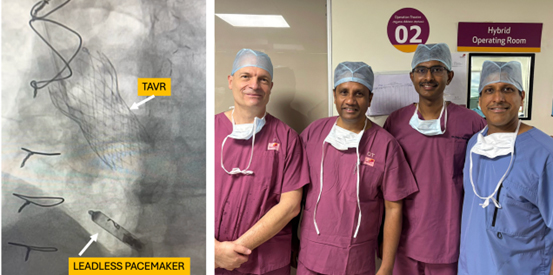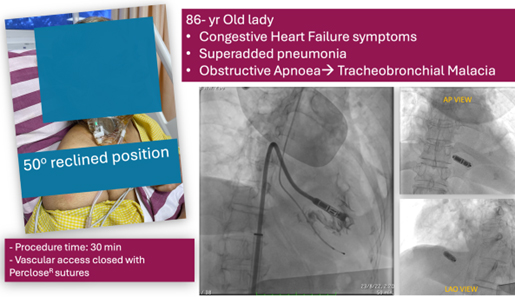Leadless Pacemakers
 Introduction
Introduction
A pacemaker is a tiny device that sends electrical impulses to the heart for normalising its rate and rhythm. It is used for treating arrhythmias when the heart beats too slowly. Traditional pacemakers consist of a pulse generator, leads (wires) implanted in the vein (subclavian, axillary or cephalic) that transmit impulses to the heart and electrodes for sensing the normal heartbeat. They are placed in the left or right chest by a mini-surgery and connected via wires to electrodes in one of the heart chambers (right atrium, right and left ventricles).
The traditional pacemaker has undergone several improvements, including a reduction in generator size, better battery quality and life, lead fidelity and refined pacing algorithms. However, these pacemakers have two disadvantages with the leads and the subcutaneous pocket for the generator. These can cause complications including lead displacement or fracture, infection, cardiac tamponade (when air, fluid or blood accumulates in a sac surrounding the heart, preventing it from pumping enough blood to the body) and rarely pulmonary complications.
What are Leadless pacemakers?
The leadless (wireless) pacemakers overcome the weaknesses of traditional pacemakers, as they are much smaller (3-4 cm). The pulse generator and electrodes are all embedded in one single device. There is no need for a separate battery or wires as a single device is implanted into the right ventricle via the femoral vein transcatheter approach under local anaesthesia. The leadless pacemaker has a similar battery life to the traditional pacemaker (5-15 years). These pacemakers are suitable for wide range of patients needing pacemakers like those with patients who are very frail for traditional pacemakers, those without any proper vascular access to the heart, those who experience recurrent pacemaker-related infections, those with tachycardia-bradycardia syndrome (heart rate fluctuates between too fast or too slow rhythms).
How do Leadless pacemakers work?
The battery, the pacing and sensing electrodes are all encased in a single capsule and inserted directly into the right ventricle. The pacemaker senses the natural heart rhythm and is programmed and tailored to deliver electrical impulses to the heart, when the natural heart rhythm is slow or infrequent, thus helping to steady the heartbeat.
Also Read: Leadless pacemakers: The future of pacing?
Procedure
- The patient should consult the cardiologist on the medicines that must be discontinued before the procedure.
- The doctor administers a local anaesthetic to the groin area to make a small incision.
- A catheter is inserted through the femoral vein. An X-ray machine guides the catheter to the heart.
- The leadless pacemaker is positioned in the right ventricle and secured with small hooks.
- The catheter is removed once the pacemaker’s programming has been tested.
- Following the procedure, the patient must lie flat with their legs straight for 2-6 hours to prevent access site bleeding.
- A sterile dressing is applied to the groin area to prevent infection.
- After a night’s hospital stay, the device is checked and the patient is discharged the next day.
EXAMPLES OF CASES FROM KAUVERY HOSPITAL:
CASE 1:
The latest generation of Leadless pacemakers- AVEIRTM was implanted for the first time in the state of Tamilnadu, in a 80-year-old with diabetes, hypertension, severe aortic stenosis, coronary artery disease, post bypass surgery, chronic obstructive lung disease, and chronic kidney disease. This patient also received a transcatheter aortic valve replacement (TAVR). For the first time in India both the implants were done at the same time.

CASE 2:
An 86-year-old lady with a frail body not capable of withstanding a conventional pacemaker received the second generation of Leadless pacemakers- the Micra-AVTM

Benefits
- The size is 90% smaller than traditional pacemakers.
- This procedure is performed under local anaesthesia, leading to a shorter duration of hospitalisation and quick recovery
- There is no need for a chest incision as the pacemaker is implanted via the femoral vein using a catheter; therefore, there is no scar.
- As there are no leads (wires), it eliminates several complications, such as the risk of infections and lead breakage and displacement, and improves patient outcomes.
- Unlike traditional pacemakers, there is no need to create a subcutaneous pocket to place the pulse generator; therefore, there is no visible bulge or discomfort, resulting in better aesthetics.
- The duration of the procedure (30-60 min) is much shorter than for traditional pacemakers (1-2 hours).
- MRI can be safely performed on patients with leadless pacemakers.
- There are no restrictions on moving the arms after it is implanted.
Also Read: Kauvery Hospital Vadapalani successfully implants Leadless Pacemaker in a woman aged 86
Current advancements in Leadless pacemakers:
The first generation of leadless pacemaker has capability of only ventricular pacing. The second generation has capability of synchronising ventricular pacing with atrial sensing. According to cardiologists, the latest generation of leadless pacemakers are capable of pacing both the atrium and the ventricles. One device is inserted in the right atrium and the other into the right ventricle, helping the synchronisation of atrioventricular contractions. The pumping of blood is more efficient and the cardiac functions are better. The battery longevity is also longer for the current generation. While the first and second generation of leadless pacemakers cannot be retrieved from the heart in the future, the latest generation of leadless pacemakers can be removed from the heart anytime in the future.
Conclusion
A leadless pacemaker includes all the necessary components in one device, which is implanted into the right ventricle to deliver electrical impulses when needed to maintain the natural heart rhythm, eliminating the requirement for leads. Leads can cause complications, including lead breakage and dislodgement and infections. The leadless pacemaker has cosmetic appeal due to the absence of a visible incision and a bump on the skin. The dual-chamber retrievable leadless pacemaker is a leap forward in cardiology, and hopefully, it will be accessible to patients and routinely implemented in the future.
Discover the frontier of cardiologic care with Kauvery Hospital, with branches in Chennai, Hosur, Salem, Tirunelveli, and Trichy. Our expert cardiac surgeons utilise the latest technology, including leadless pacemakers, to ensure you receive the best possible treatment for heart rhythm disorders. Trust Kauvery Hospital for your heart health needs today.
DISCLAIMER: Discuss in detail the benefits and risks of the leadless pacemaker versus traditional pacemaker implant with your treating cardiac electrophysiologist.
Kauvery Hospital is globally known for its multidisciplinary services at all its Centers of Excellence, and for its comprehensive, Avant-Grade technology, especially in diagnostics and remedial care in heart diseases, transplantation, vascular and neurosciences medicine. Located in the heart of Trichy (Tennur, Royal Road and Alexandria Road (Cantonment), Chennai (Alwarpet & Vadapalani), Hosur, Salem, Tirunelveli and Bengaluru, the hospital also renders adult and pediatric trauma care.
Chennai Alwarpet – 044 4000 6000 • Chennai Vadapalani – 044 4000 6000 • Trichy – Cantonment – 0431 4077777 • Trichy – Heartcity – 0431 4003500 • Trichy – Tennur – 0431 4022555 • Hosur – 04344 272727 • Salem – 0427 2677777 • Tirunelveli – 0462 4006000 • Bengaluru – 080 6801 6801
- Jan 01, 2025
